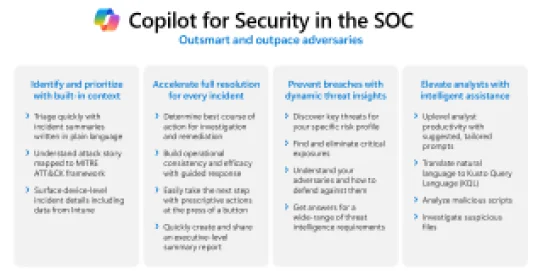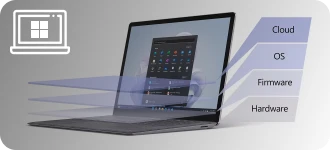At CISO Online™, we harness the power of Microsoft Sentinel to elevate our security services and deliver unparalleled protection to your business.
Additionally, the lack of automated threat detection and response increases the risk of human error and slows down incident response times, leaving organisations vulnerable to prolonged attacks and potential compliance violations.
Security information and event management, SIEM for short, is a solution that helps organizations detect, analyse, and respond to security threats before they harm business operations.
SIEM, pronounced “sim,” combines both security information management (SIM) and security event management (SEM) into one security management system. SIEM technology collects event log data from a range of sources, identifies activity that deviates from the norm with real-time analysis, and takes appropriate action.
In short, SIEM gives organizations visibility into activity within their network so they can respond swiftly to potential cyberattacks and meet compliance requirements.
In the past decade, SIEM technology has evolved to make threat detection and incident response smarter and faster with artificial intelligence.
Move faster with Microsoft Sentinel and Defender XDR, a security operations (SecOps) platform that brings together the capabilities of extended detection and response (XDR) and security information and event management (SIEM).
Unified Security Operations (USO) is a cybersecurity approach that integrates various security technologies and processes into a cohesive and centralised framework. It combines security information and event management (SIEM), threat intelligence, incident response, and other security operations functions to provide comprehensive visibility and control over an organisation’s security posture.
Microsoft Sentinel is a scalable, cloud-native, Security Information Event Management (SIEM) and Security Orchestration Automated Response (SOAR) solution backed by Azure cloud-native features and Copilot for Security AI machine learning and analysist capabilities.
Microsoft Sentinel contributes to Unified Security Operations by providing a centralised platform for security monitoring, threat detection, and incident response across an organisation’s entire digital estate. It collects and analyses data from various sources, including security logs, network traffic, and cloud services, to detect and investigate security threats in real-time. Sentinel utilises advanced analytics, machine learning, and automation capabilities to identify suspicious activities, correlate security events, and prioritise alerts for investigation. It streamlines security operations by providing a unified view of security incidents and facilitating collaboration among security teams.
Utalising our partnership with Microsoft, CISO Online brings Unified Security Operations to Businesses with the use of, Defender XDR, Sentinel and Copilot for Security.


Microsoft Copilot for Security equips security teams with purpose-built capabilities at every stage of the security lifecycle, embedded right into the unified security operations platform in the Defender portal.
Early users of Copilot for Security have already seen significant measurable results when integrated in their SOC, transforming their operations and boosting their defense and posture against both ongoing and emerging threats.
Prevent breaches with dynamic threat insight
Copilot for Security leverages the rich portfolio of Microsoft Security products to produce enriched insights for security analysts in the context of their workflow. You will be able to use Copilot for Security with Microsoft Defender Threat Intelligence and Threat Analytics in the Defender portal to tap into high-fidelity threat intelligence on threat actors, tooling and infrastructure and easily discover and summarize recommendations specific to your environment’s risk profile, all using natural language. These insights can help security teams improve their security posture by prioritizing threats and managing exposures proactively against adversaries, keeping their organizations protected from potential breaches.
Identify and prioritize with built-in context
“Copilot for Security is allowing us to re-envision security operations. It will be critical in helping us close the talent gap.” Greg Petersen Sr. Director – Security Technology & Operations, Avanade
Automation of common manual tasks with Copilot frees up analyst time and allows you to focus on more complex and urgent demands. For example, analysts need to understand the attack story and impact to determine next steps, and this often requires time and effort to collect and understand all of the relevant details. To make this task faster and easier, Copilot’s incident summaries, with AI-powered data processing and contextualization, provides this content readily available, saving significant triage time. Complimenting Microsoft Defender XDR’s unique ability to correlate incidents from a variety of workloads, Copilot’s incident summary provides the attack story and potential impact directly in the incident page.

Secure more of your digital estate with scalable, integrated coverage for a hybrid, multicloud, multiplatform business.

Optimize your security operations center (SOC) with advanced AI, world-class security expertise, and comprehensive threat intelligence.

Stay ahead of evolving cyberthreats with a unified set of tools to monitor, manage, and respond to incidents.

Get started faster while reducing infrastructure and maintenance with a cloud-native software as a service (SaaS) solution.

Tailored packages for SMB's to uplift cyber security

Risk-based approach for large enterprises to uplift cyber security

Work Security Beyond Boundaries with Microsoft Surface
Unified Security Operations refers to the integration and coordination of various security measures and operations across an organization's infrastructure. It aims to create a cohesive approach to managing and mitigating security threats, leveraging tools, processes, and teams to work together effectively.
A unified approach ensures that all security measures are aligned and work together seamlessly, which enhances the organization's ability to detect, respond to, and recover from security incidents. It also helps in reducing silos, improving communication, and increasing the efficiency of security operations.
Key components often include:
Security Information and Event Management (SIEM): Centralized logging and analysis of security events.
Security Orchestration, Automation, and Response (SOAR): Automation of security workflows and response actions.
Threat Intelligence: Integration of threat intelligence feeds to stay updated on emerging threats.
Incident Response: Coordinated response strategies and playbooks for handling security incidents.
Vulnerability Management: Continuous assessment and remediation of vulnerabilities within the environment.
Automation plays a key role in increasing the efficiency and effectiveness of security operations by automating repetitive tasks, orchestrating workflows, and enabling rapid response to incidents. This reduces the workload on security teams and allows them to focus on more complex and strategic tasks.
Assessing their current security posture and identifying gaps.
Integrating existing security tools and platforms into a cohesive system.
Adopting a SIEM and SOAR solution to centralize and automate security operations.
Developing and standardizing incident response playbooks.
Ensuring continuous monitoring and updating of security measures based on evolving threats.
Improved Threat Detection and Response: Faster identification and mitigation of threats.
Enhanced Efficiency: Streamlined workflows and reduced manual effort through automation.
Better Collaboration: Improved communication and coordination among security teams.
Comprehensive Visibility: Centralized monitoring and analysis of security events across the organization.
Scalability: Ability to scale security operations as the organization grows.
A SIEM solution is security software that gives organizations a bird’s-eye-view of activity across their entire network so they can respond to threats faster—before business is disrupted.
SIEM software, tools and services detect and block security threats with real-time analysis. They collect data from a range of sources, identify activity that deviates from the norm, and take appropriate action.
SIEM tools collect, aggregate, and analyse volumes of data from an organization’s applications, devices, servers, and users in real-time so security teams can detect and block attacks. SIEM tools use predetermined rules to help security teams define threats and generate alerts.
SIEM systems vary in their capabilities but generally offer these core functions:
Log management: SIEM systems gather vast amounts of data in one place, organize it, and then determine if it shows signs of a threat, attack, or breach.
Event correlation: The data is then sorted to identify relationships and patterns to quickly detect and respond to potential threats.
Incident monitoring and response: SIEM technology monitors security incidents across an organization’s network and provides alerts and audits of all activity related to an incident
SIEM systems can mitigate cyber risk with a range of use cases such as detecting suspicious user activity, monitoring user behaviour, limiting access attempts and generating compliance reports.
SIEM tools offer many benefits that can help strengthen an organization’s overall security posture, including:
A central view of potential threats
Real-time threat identification and response
Advanced threat intelligence
Regulatory compliance auditing and reporting
Greater transparency monitoring users, applications, and devices
A SIEM system collects and analyses data from various sources across the network to detect and alert on potential security incidents. It provides a centralized view of security events, which is crucial for a unified approach, enabling quicker detection and more effective incident response.
Organizations of all sizes use SIEM solutions to mitigate cybersecurity risks and meet regulatory compliance standards. The best practices for implementing a SIEM system include:
Define the requirements for SIEM deployment
Do a test run
Gather sufficient data
Have an incident response plan
Keep improving your SIEM
SIEM is an important part of an organization’s cybersecurity ecosystem. SIEM gives security teams a central place to collect, aggregate, and analyse volumes of data across an enterprise, effectively streamlining security workflows. It also delivers operational capabilities such as compliance reporting, incident management, and dashboards that prioritize threat activity.
SIEMs have adapted to keep pace with ever-evolving cyber threats. When they first emerged more than 15 years ago, SIEM tools were used to help organizations comply with various regulations, such as the Payment Card Industry Data Security Standards (PCI DSS). Today, effective SIEM solutions are cloud-based and leverage artificial intelligence to accelerate threat detection, investigations, and response.
SIEM and SOAR technologies both play significant roles in cybersecurity.
Simply put, SIEM helps organizations make sense of the data collected from applications, devices, networks, and servers by identifying, categorizing, and analysing incidents and events.
SOAR stands for Security Orchestration, Automation and Response and describes software that addresses threat and vulnerability management, security incident response, and security operations (SecOps) automation.
SOAR helps security teams prioritize threats and alerts created by SIEM by automating incident response workflows. It also helps find and resolve critical threats faster with extensive cross-domain automation. SOAR surfaces real threats from massive amounts of data and resolves incidents faster.
Extended detection and response, or XDR for short, is an emerging approach to cybersecurity to improve threat detection and response with deep context into specific resources.
XDR platforms help:
Investigate attacks with understanding into specific resources, across platforms and clouds—unified across endpoints, users, applications, IoT, and cloud workloads.
Protect resources and harden posture to guard against threats like ransomware and phishing. Respond to threats faster using auto-remediation. SIEM solutions provide a comprehensive SecOps command-and-control experience across the entire enterprise.
SIEM platforms help:
Manage security operations from your bird's-eye-view of the estate.
Collect and analyse data from your entire organization to detect, investigate, and respond to incidents that cross silos.
Enhance SecOps efficiency with customizable detections, analytics, and built-in automation
A strategy that includes both broad visibility across the entire digital estate and depth of knowledge into specific threats, combining SIEM and XDR solutions, helps SecOps teams overcome their daily challenges.

